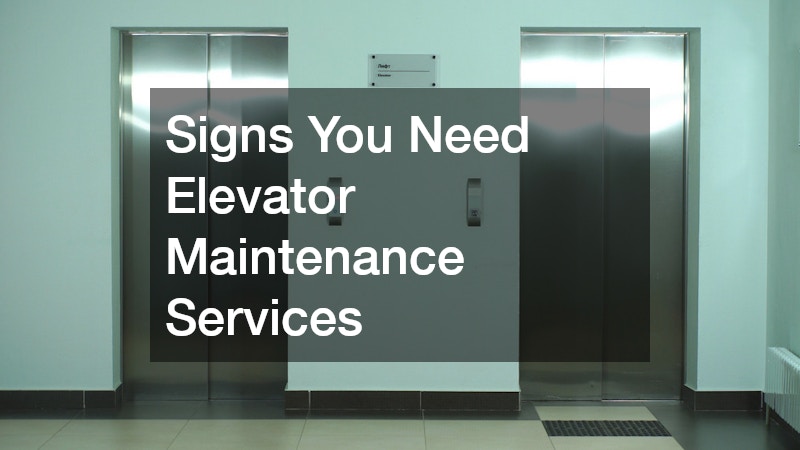Elevators are vital to the smooth operation of any multi-story building, whether it’s a commercial space, apartment complex, or hotel. They ensure accessibility, convenience, and safety for everyone who uses them daily. However, like any mechanical system, elevators require consistent maintenance to function properly. When problems go unnoticed or ignored, they can quickly lead to costly breakdowns or even safety hazards.
Recognizing the signs that your elevator needs maintenance can prevent minor issues from becoming major ones. Below, we’ll discuss the most common indicators that it’s time to call for professional elevator maintenance services.
1. Slow or Delayed Response Time
One of the first signs that an elevator may need maintenance is a delay between pressing the call button and the elevator’s arrival. While a few seconds is normal, noticeable lag times often signal wear and tear in mechanical parts or software problems within the control system.
If your elevator takes significantly longer than usual to open doors, move between floors, or respond to button presses, it’s not something to overlook. Delays can result from issues with the relay system, outdated motors, or deteriorating cables—all of which require professional attention.
Tip: Keep track of how long your elevator takes to travel from floor to floor. If the time continues to increase, schedule a maintenance inspection before it worsens.
2. Unusual Noises During Operation
Elevators should operate smoothly and quietly. Grinding, clanking, or screeching noises are red flags. These sounds typically indicate problems such as worn-out pulleys, loose components, or misaligned gears.
A well-maintained elevator runs with minimal sound. When strange noises start occurring, it’s a clear sign that something inside the system is struggling to work properly. Ignoring these sounds can lead to a mechanical breakdown and potentially endanger passengers.
Common sounds to watch for include:
-
Grinding: Often indicates friction due to lack of lubrication or worn bearings.
-
Banging or clunking: May suggest issues with the counterweights or guide rails.
-
Whining or humming: Could be a sign of electrical motor strain.
3. Jerky or Uneven Movement
A properly functioning elevator should start, move, and stop smoothly. If passengers feel a sudden jolt, drop, or uneven leveling when the elevator reaches a floor, there’s likely a mechanical issue.
Uneven stops—when the elevator doesn’t align perfectly with the floor—are particularly dangerous, as they create tripping hazards. These issues are often related to problems with the brake system, leveling sensors, or hydraulic mechanisms.
Action step: Schedule maintenance immediately if passengers report bumpy rides or notice misaligned floors.
4. Strange Odors or Overheating
An unusual burning smell, especially near the machine room or elevator shaft, is a serious warning sign. It may indicate electrical issues such as overheating circuits or a failing motor.
Elevators have complex electrical systems that require periodic checks to prevent fire hazards. If you notice an unusual odor or excessive heat coming from the elevator area, shut down the elevator and contact maintenance right away.
Prevention tip: Routine inspections can detect frayed wires or overheating components before they cause major damage.
5. Frequent Breakdowns or Error Codes
If your elevator has been experiencing frequent shutdowns or displaying error codes, you’re likely overdue for maintenance. Modern elevators often include diagnostic systems that show fault codes on their control panels—these shouldn’t be ignored.
Frequent issues such as getting stuck between floors or sudden stops indicate deeper mechanical or electrical problems. Repeated breakdowns also frustrate building occupants and can hurt your building’s reputation if you manage a commercial property.
Bottom line: If you’ve had to call for emergency repairs more than once or twice in a short time frame, it’s time to invest in consistent preventive maintenance.
6. Increased Energy Bills
An elevator that isn’t running efficiently may consume more electricity than usual. This is often due to worn motors, aging control systems, or poor lubrication causing additional strain.
If you notice a spike in your building’s energy costs without any other clear reason, your elevator system could be to blame. Modernization or proper servicing can help restore energy efficiency and reduce operational costs.
Pro tip: Ask your maintenance provider about energy-efficient upgrades that can be implemented during routine service.
7. Door Malfunctions
Elevator doors are one of the most active parts of the system—they open and close hundreds of times each day. Over time, the sensors, rollers, or tracks may wear out.
If your elevator doors begin to close too quickly, fail to close completely, or get stuck, it’s a definite sign that maintenance is required. Faulty doors aren’t just an inconvenience; they pose a safety risk to passengers entering or exiting the elevator.
Elevators are complex machines that demand consistent care. Ignoring the warning signs—like strange noises, jerky rides, or frequent breakdowns—can lead to more expensive repairs and jeopardize passenger safety.
Professional elevator maintenance services not only correct existing issues but also prevent future ones. Regular inspections, timely repairs, and occasional modernization keep your system running smoothly, reduce liability risks, and enhance user satisfaction.
If your elevator has shown any of the warning signs above, it’s time to call a trusted maintenance provider. A proactive approach today can save you from costly downtime and ensure your building remains safe, reliable, and efficient.



